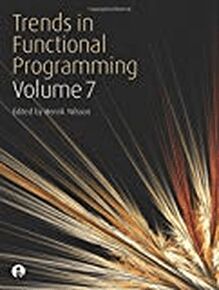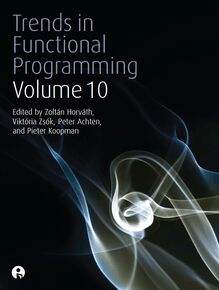-
 Univers
Univers
-
 Ebooks
Ebooks
-
 Livres audio
Livres audio
-
 Presse
Presse
-
 Podcasts
Podcasts
-
 BD
BD
-
 Documents
Documents
-
- Cours
- Révisions
- Ressources pédagogiques
- Sciences de l’éducation
- Manuels scolaires
- Langues
- Travaux de classe
- Annales de BEP
- Etudes supérieures
- Maternelle et primaire
- Fiches de lecture
- Orientation scolaire
- Méthodologie
- Corrigés de devoir
- Annales d’examens et concours
- Annales du bac
- Annales du brevet
- Rapports de stage
La lecture à portée de main
Vous pourrez modifier la taille du texte de cet ouvrage
Découvre YouScribe en t'inscrivant gratuitement
Je m'inscrisDécouvre YouScribe en t'inscrivant gratuitement
Je m'inscrisEn savoir plus
Vous pourrez modifier la taille du texte de cet ouvrage
En savoir plus

Description
Stephen Gilmore is a Senior Lecturer in the Laboratory for Foundations of Computer Science at The University of Edinburgh.
Sujets
Informations
| Publié par | Intellect Books Ltd |
| Date de parution | 01 janvier 2005 |
| Nombre de lectures | 1 |
| EAN13 | 9781841509150 |
| Langue | English |
Informations légales : prix de location à la page 0,1600€. Cette information est donnée uniquement à titre indicatif conformément à la législation en vigueur.
Extrait
Trends in Functional Programming
volume 4
Edited by
Stephen Gilmore
First Published in the UK in 2005 by Intellect Books, PO Box 862, Bristol BS99 IDE, UK. First Published in the USA in 2005 by Intellect Books, ISBS, 920 NE 58th Ave. Suite 300, Portland, Oregon 97213-3786, USA.
Copyright 2005 Intellect Ltd
All rights reserved. No part of this publication may be reproduced, stored in a retrieval system, or transmitted, in any form or by any means, electronic, mechanical, photocopying, recording, or otherwise, without written permission.
A catalogue record for this book is available from the British Library.
Electronic ISBN 1-84150-915-9 / ISBN 1-84150-122-0 ISSN 1743-4505 (Print)
Printed and bound in Great Britain by Antony Rowe Ltd.
Contents
1 Is It Time for Real-Time Functional Programming?
1.1 Introduction
1.2 What is Real-Time Programming?
1.2.1 The Importance of Real-Time Systems
1.2.2 Essential Properties of Real-Time Languages
1.3 Languages for Programming Real-Time Systems
1.3.1 Using General Purpose Languages for Real-Time Programming
1.3.2 Domain-Specific Languages for Real-Time Programming
1.3.3 Functional Language Approaches
1.4 Bounding Time and Space Usage
1.4.1 Real-Time Dynamic Memory Management
1.4.2 Static Analyses for Bounding Memory Usage
1.4.3 Worst Case Execution Time Analysis
1.4.4 Syntactically Restricted Functional Languages
1.5 Functional Languages for Related Problem Areas
1.6 The Hume Language
1.6.1 Real Time and Space Behaviour of FSM-Hume Programs
1.7 TheChallenges
1.8 Conclusion
2 FSM-Hume is Finite State
2.1 Introduction
2.2 Single Box FSM-Hume Programs are Finite State
2.3 Multi-Box FSM-Hume Programs are Finite State
2.4 Example: Vehicle Simulation
2.4.1 Single-box FSM-Hume
2.5 Conclusion
3 amelot and Grail: Resource-Aware Functional Programming for the JVM
3.1 Introduction
3.2 Camelot
3.2.1 Basic Features of Camelot
3.2.2 Diamonds and Resource Control
3.3 Grail
3.3.1 The Grail Type System
3.3.2 Compilation of Grail
3.4 Compiling Camelot to Grail
3.4.1 Representing Data
3.4.2 Compilation of Programs
3.4.3 Initial Transformations
3.4.4 Compilation of Expressions
3.5 Performance
3.6 Final Remarks
4 O Camelot: Adding Objects to a Resource-Aware Functional Language
4.1 Introduction
4.2 Camelot
4.3 Extensions
4.4 Typing
4.5 Translation
4.6 Objects and Resource Types
4.7 Related Work
4.8 Conclusion
5 Static Single Information from a Functional Perspective
5.1 Introduction
5.2 Related Work
5.3 Static Single Information
5.4 Transformation
5.5 Optimistic versus Pessimistic
5.6 Converting Functional Programs Back to SSI
5.7 Motivation
5.8 Conclusions
6 Implementing Mobile Haskell
6.1 Introduction
6.2 Mobile Haskell
6.2.1 Communication Primitives
6.2.2 Discovering Resources
6.2.3 Remote Thread Creation
6.2.4 A Simple Example
6.3 Implementation Design
6.3.1 Introduction
6.3.2 Evaluating Expressions before Communication
6.3.3 Sharing Properties
6.3.4 MChannels
6.4 TheImplementation
6.4.1 Packing Routines
6.4.2 Communicating User Defined Types
6.4.3 Evaluating Expressions
6.4.4 Implementation of MChannels
6.5 Initial Evaluation
6.6 Related Work
6.7 Conclusions and Future Work
7 Testing Scheme Programming Assignments Automatically
7.1 Introduction
7.2 WebAssign and AT(x)
7.3 A Sample Session
7.4 Structure of the AT(x) Framework
7.4.1 Components of the AT(x) System
7.4.2 Communication Interface of the Analysis Component
7.4.3 Function and Implementation of the Interface Component
7.4.4 Global Security Issues
7.5 The Core Analysis Component
7.5.1 Requirements on the Analysis Components
7.5.2 Analysis of Scheme Programs
7.6 ImplementationandExperiences
7.7 Related Work
7.8 Conclusions and Further Work
8 Testing Reactive Systems with GAST
8.1 Introduction
8.2 Overview of G ST
8.2.1 Testing and Results
8.2.2 Evaluating Test Results
8.2.3 LogicalOperators inG ST
8.2.4 Automatic Generation of Test Values
8.3 Specifying Reactive Systems in G ST
8.3.1 Labelled Transition Systems
8.3.2 Example: Conference Protocol
8.3.3 Executing a Deterministic LTS
8.3.4 The Implementation Under Test
8.3.5 Testing the Conference Protocol
8.3.6 Implementations with Other Types
8.4 BetterTest Data Generationfromthe LTS
8.5 Functional and Nondeterministic Specifications
8.6 Testing Nondeterministic Systems
8.7 Related Work
8.8 Conclusion
PREFACE
This volume is the proceedings of the Fourth International Symposium on Trends in Functional Programming held in Edinburgh, on September 11th and 12th, 2003. For the first time this year the TFP symposium was co-located with the Implementation of Functional Languages workshop.
The Trends in Functional Programming series occupies a unique place in the spectrum of functional programming events because of its highly commendable policy of encouraging new speakers, particularly PhD students, to air their work to a receptive and friendly audience. By encouraging the next generation of functional programmers in this way the workshop helps to instill the understanding that functional programming is more than just syntax, semantics and type systems and nourishes the essence of the subject itself.
This year the papers from the workshop have addressed the research problems at the forefront of practical application of functional languages as in the papers on real-time functional programming in Hume from Kevin Hammond, Greg Michaelson and Jocelyn Serot and resource-bounded functional programming in Camelot from Kenneth MacKenzie and Nicholas Wolverson.
Functional programming languages are supported by sophisticated implementations. Two papers address this aspect of functional programming research, Jeremy Singer's paper on static single information and the paper on the implementation of Mobile Haskell from Andre Rauber Du Bois, Phil Trinder and Hans-Wolfgang Loidl.
For all of their virtues, functional programs are not automatically error-free so the book closes with two papers on testing functional programs from Manfred Widera and from Pieter Koopman and Rinus Plasmeijer.
I would like to thank the organisers of IFL, Abyd Al Zain, Andre Rauber Du Bois, June Maxwell, Greg Michaelson, Jan Henry Nystrom and Phil Trinder for their work in organising the workshop registrations, the excursion, delegate packs, room bookings, audio-visuals and many other aspects of the event and for allowing the TFP meeting to make use of their industriousness in making all of this run smoothly.
My thanks also go to all of the authors for preparing their papers carefully using Hans-Wolfgang Loidl's LATEX style file and to the referees for their thorough and rapid reviewing of the papers which were submitted.
The Trends in Functional Programming workshop gratefully acknowledges the support of the British Computer Society Formal Aspects of Computer Science special interest group.
Stephen Gilmore, Edinburgh
Chapter 1
Is It Time for Real-Time Functional Programming?
Kevin Hammond 1
Abstract This paper explores the suitability of functional languages for programming real-time systems. We study the requirements of real-time systems in general, outline typical language approaches for this domain, consider issues relating to memory and time usage and explore how all existing functional languages, including our own language Hume, match these requirements. We conclude by posing some research challenges that functional language designs and implementations must meet if they are to be regarded as suitable vehicles for realtime systems implementation.
1.1 INTRODUCTION
Functional programs use large amounts of memory. Functional programs are slow. It is impossible to predict memory and other resource usage for functional languages. Clearly, functional languages are therefore unsuitable for use in restricted memory settings with strong time requirements. Or are they? This paper explores the suitability of functional language designs for use in settings with strong limitations on resource usage such as real-time systems. It compares current functional approaches, including our own Hume notation (Sec. 1.6), with those used by other language paradigms and outlines some challenges for functional language designs and implementations that must be met if functional programming is to be used for serious real-time programming.
1.2 WHAT IS REAL-TIME PROGRAMMING?
The key characteristic of a real-time system is that its correctness depends not only on its functional behaviour, but also on the (real-)time or times at which it produces those results [15] . Such systems can be classified as having either soft realtime or hard real-time properties. Soft real-time has been defined as a situation where nothing really serious happens if a time constraint is not met [3] . Examples of soft real-time systems might include computer games, telephone switches, digital set-top boxes or digital sound cards. In contrast, hard real-time involves guaranteed system response and is often associated with safety-critical systems or ones with high penalty cost for failure. Examples include avionics control software, autonomous vehicles, or software used by stock market traders. In many situations, such as embedded systems, such real-time constraints are combined with other resource restrictions including memory limitations and even power consumption requirements. Despite the focus on real-time, such systems need not necessarily be ultra high-performance. The problem is to design systems that are sufficiently reliable and have minimal cost and acceptable performance. Doing so in a cost-effective manner is a major bonus.
1.2.1 The Importance of Real-Time Systems
Real-time systems have been growing in importance in recent years. Numerically, a very high percentage of all computer systems produced today have real-time ch
-
 Univers
Univers
-
 Ebooks
Ebooks
-
 Livres audio
Livres audio
-
 Presse
Presse
-
 Podcasts
Podcasts
-
 BD
BD
-
 Documents
Documents
-
Jeunesse
-
Littérature
-
Ressources professionnelles
-
Santé et bien-être
-
Savoirs
-
Education
-
Loisirs et hobbies
-
Art, musique et cinéma
-
Actualité et débat de société
-
Jeunesse
-
Littérature
-
Ressources professionnelles
-
Santé et bien-être
-
Savoirs
-
Education
-
Loisirs et hobbies
-
Art, musique et cinéma
-
Actualité et débat de société
-
Actualités
-
Lifestyle
-
Presse jeunesse
-
Presse professionnelle
-
Pratique
-
Presse sportive
-
Presse internationale
-
Culture & Médias
-
Action et Aventures
-
Science-fiction et Fantasy
-
Société
-
Jeunesse
-
Littérature
-
Ressources professionnelles
-
Santé et bien-être
-
Savoirs
-
Education
-
Loisirs et hobbies
-
Art, musique et cinéma
-
Actualité et débat de société
- Cours
- Révisions
- Ressources pédagogiques
- Sciences de l’éducation
- Manuels scolaires
- Langues
- Travaux de classe
- Annales de BEP
- Etudes supérieures
- Maternelle et primaire
- Fiches de lecture
- Orientation scolaire
- Méthodologie
- Corrigés de devoir
- Annales d’examens et concours
- Annales du bac
- Annales du brevet
- Rapports de stage










